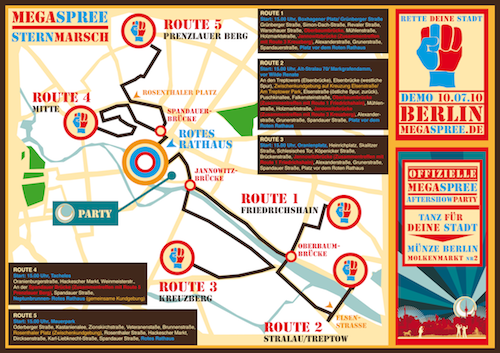Stephan Hoffken and Vincent Rebers engage in ‘bottom-up activation’, using the new possibilities in a internet-based network society.
- Berlin’s city administration proposed to cut the Stadtebauforderung for 2011 from 610 million Euro to 305 million Euro. Stephan and Vincent set up a website and let participants sign a petition against this budget cut. Within one week 1000 people signed the petition.
- Activation of the public in Berlin against plans to redevelop the border of the river Spree. The current condition – a wasteland with cultural program like the arthouse Tacheles – will be transformed into a office district. Stephan and Vincent set up a website ‘Megaspree – Rette deine Stadt’ to activate the audience. They connected the website to social media like Youtube, Twitter and Facebook. The real and virtual world got connected successfully: more than 7000 people protested against the plans:
- Mega GPS Squatting: a mapping tool showing the useage of the ‘wastelands’ along the Spree river to show ‘politicians who never go there’ the factual situation on the site.
- In the project ‘Fix my Street’, civilians can report complaints about their neighbourhood through their mobile devices. Trash, sidewalks in need of repairing, broken streetlights, all can be reported to a website that connects to the local government. The website shows who is responsible for the problem as well.
- Re-introducing old typography into the existing urban space. This application, developed together with the museum of letters, reveals what kind of old logo’s used to be on the façades. This project is another example of the connection between the real and the virtual world.
Video below: talk by Stephan Hoffken and Vincent Rebers at ‘Designing the Hybrid City’




